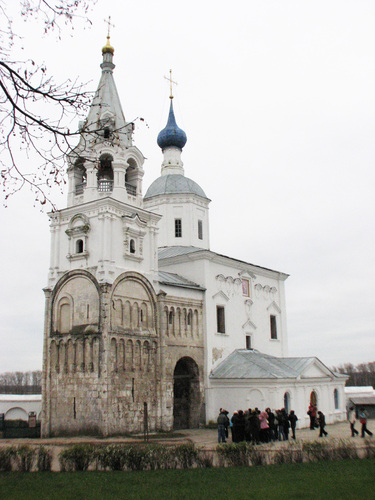
Photo Panoramio
Vladimir
Link to Google-Earth file Vladimir.kmz
This requires that you have GE on your hard disc.
History of Vladimir
The name and the founding of the city is traditionally attributed to Vladimir Monomakh, who inherited the region as part of the Rostov-Suzdal principality in 1093. Another version, based on the Hypatian Codex, invokes Vladimir I the Great of Kiev, the "father" of Russian Orthodoxy in 990. Regardless of which founding date is correct, the city became historically sigmificant after the turn of the 12th century. Under Andrei Bogolyubsky (1157-1175), Yuri Dolgoruky's son, it became the center of the Vladimir-Suzdal principality. Andrei built the Golden Gates and the Cathedral of the Assumption. In 1164 he even attempted to establish a new metropolitanate in Vladimir, separate from that of Kiev, but was rebuffed by the Patriarch of Constantinople.
Russian,German, and Georgian masons worked on Vladimir's white stone cathedrals, towers, and palaces. Unlike other northern buildings, their exteriors were elaborately carved with high relief stone sculptures. Only three of these edifices stand today: the Assumption Cathedral, the Cathedral of St.;Demetrios, and the Golden Gate. During Andrei's reign, a royal palace in was built in Bogolyubovo, as well as the Intercession Church on the Nerl, now considered one of the jewels of ancient Russian architecture. Andrei was assassinated at his palace in Bogolyubovo in 1175.
This
golden Age came to an uptupt end when Batu, the Khan of the Golden
Horde, sacked the city in 1238 and burned down its buildings
including the members of the pricely Dolgorky family who had sought
refuge in its cathedral. Vladimir never fully recovered. The
Metropolitan of all Rus (originally in Kiev) move his seat from
Valdomir to Moscow. Moscow superseded Vladimir as the seat of the
Grand Prince of Rus and the Assumption Cathedral in the Moscow Kreml
became the place of their coronations.
Adapted from Wikipedia
Bogolyubovo,
the Palace of Andrei Bogolyubsky
1158-1165

Photo
Panoramio
Bogolyubovo
Convent, rests on the foundations of Andrei Bogolyubsky's original
Palace (1158-1165), of which only the foundations under the belltower
and a gate survive. The church, the tower, and the other buildings of
the ensemble are from then 18th century.
Bogolyubovo,
the,Church of the Intercession on the Nerl
1165

Photo
RWFG 1976
Commissioned by Andrei
Bogolyubsky in 1165 in atonement for the murder of his son.
It is
one of the most beloved monuments of early Muscovite Rus.
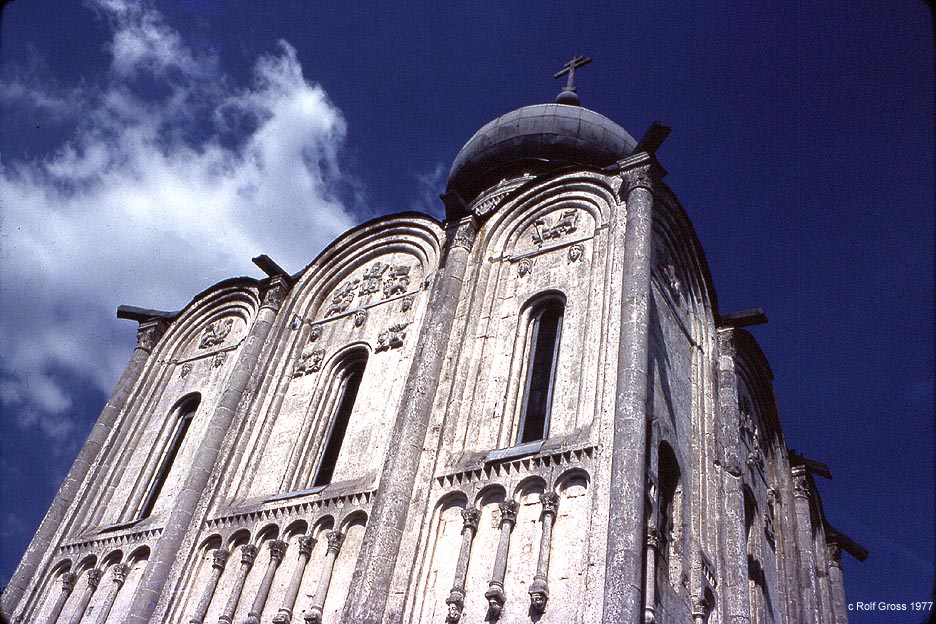
Photo
RWFG 1976
Like the Dimitry Cathedral in Vladimir it was built
by Georgian craftsmen, viz.its proportions and the
Caucasian
sculptural decoration on its outside.
Vladimir,
Uspenskiy Cathedral
1185-1189
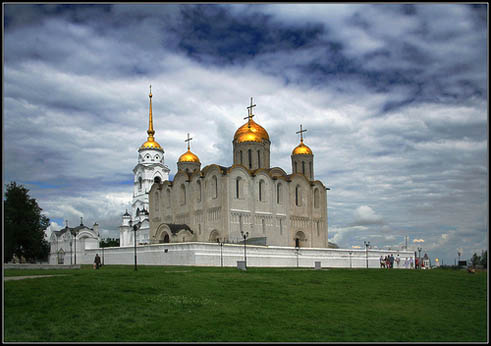
Photo
Panoramio
The
Uspensky Cathedral, the Church of the Dormition or Assumption of the
Mother of God, was enlarged by Vsevolod III, in 1185-1189. Rublyov's
frescoes on the inside were painted in 1408.

Photo
icon-art.com
Andrey Rubelyov "The Vladimirskaya Mother of God"
1408,
Vladimir Museum. Painted to replace the Byzantine
Vladimirskaya Elusa which had been taken to Moscow in 1385 to protect
that city from Timurleng's hordes.
Link
to the
The
Rubelyov Deesis in the Iconostasis of the Uspensky Cathedral
The
iconostasis of the Assumption Cathedral is one of Rubelyov's
celebrated master pieces.
Each panel is 314 × 128 cm large!
- Because of its extent it has a seperate page on my website.
Vladimir, Church of St. Dimitry
1194-1197
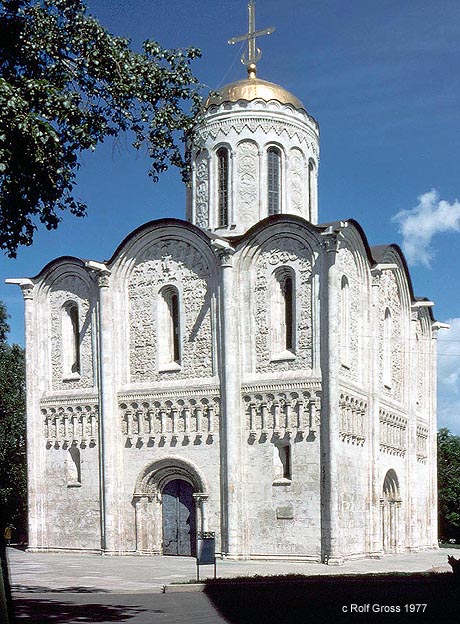
Photo
RWFG 1977
Vladimir Dimitry Cathedral is one of the oldest churches in Russia. It was commissioned by Vsevolod III (1194-1197), and like the church on the Nerl built by Georgian craftsmen loaned by Queen Tamara (1160-1213) of Georgia. The Caucasian sculptural decorations on their outside are unique in Russia, their themes are directly related to the churches in Ateni and Mtskheta in Georgia. - A son of Vsevolod was Tamara's first husband, whom, after her father's death, she sent back home because of a non-consumated marriage. The church was restored in the 15th cent. Marginal fragments of frescoes painted by Greek artists from Thessaloniki - where the relics of St. Demitrius (a bloodied shred of his shirt) had come from - have been discovered under plaster in the late 19th century.
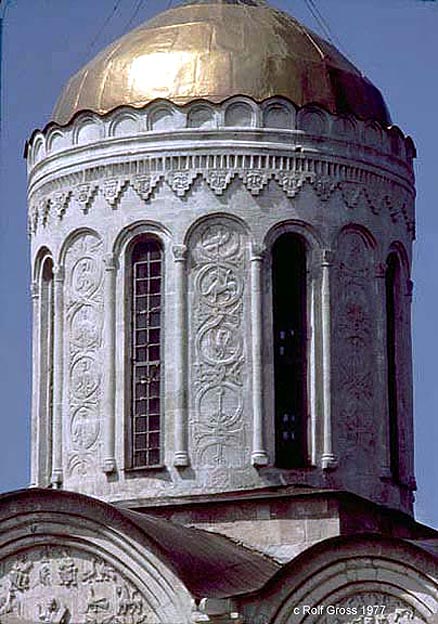
Photo
RWFG 1977
Caucasian sculptural ornaments on the tambour of
the cathedral. In Georgia the roof would have been conical.
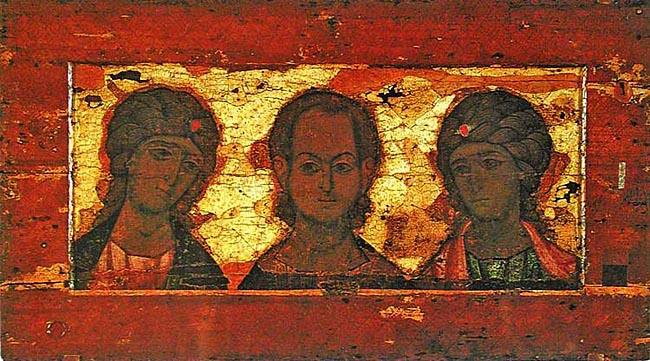
Photo
icon-art.com
Archangel
Mikhael - Christ Emanuel - Archangel Gabriel, (end 12th cent) one of
the earliest Russian representations of the Trinity.
It served as
the lintel over the Golden Door of the deesis of the Dimitry
Cathedral in Vladimir. In the 16th cent it was taken to the Uspensky
Cathedral in Moscow and is now in the Tretyakov Gallery.
Vladimir, Rozhdestvenskiy Monastery
1222-1225
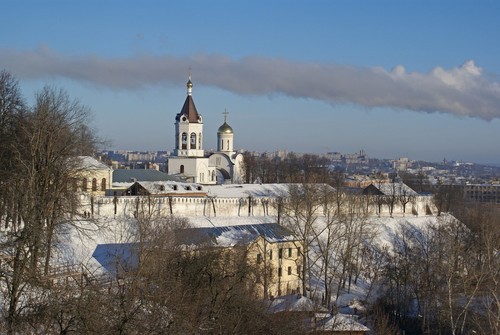
Photo
Panoramio
The
Monastery and the Church of the Nativity 1222-1225
and later